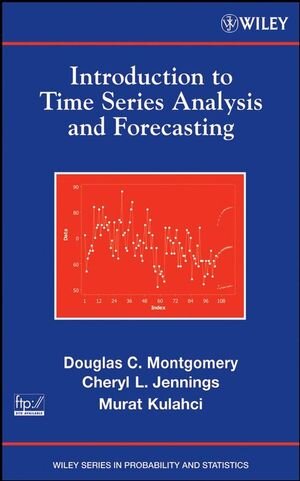
„This would be an appropriate source for use in a first course intime series analysis. It might also be useful as a reference forresearchers who want to apply time series analysis to their datasets.“ (CHOICE, October 2008)
„The result is a book that can be used with a wide variety ofaudiences, with different interests and technical backgrounds, whose common interests are understanding how to analyzetime-oriented data and constructing good short-term statisticallybased forecasts.“ (Mathematical Reviews, 2008m)
„The book is great for readers who need to apply the methods andmodels presented but have little background in mathematics andstatistics.“ (MAA Reviews, July 2008)
Introduction to Time Series Analysis and Forecasting
von Douglas C. Montgomery, Cheryl L. Jennings und Murat KulahciAn accessible introduction to the most current thinking in and practicality of forecasting techniques in the context of time-oriented data.
Analyzing time-oriented data and forecasting are among the most important problems that analysts face across many fields, ranging from finance and economics to production operations and the natural sciences. As a result, there is a widespread need for large groups of people in a variety of fields to understand the basic concepts of time series analysis and forecasting. Introduction to Time Series Analysis and Forecasting presents the time series analysis branch of applied statistics as the underlying methodology for developing practical forecasts, and it also bridges the gap between theory and practice by equipping readers with the tools needed to analyze time-oriented data and construct useful, short- to medium-term, statistically based forecasts.
Seven easy-to-follow chapters provide intuitive explanations and in-depth coverage of key forecasting topics, including:
* Regression-based methods, heuristic smoothing methods, and general time series models
* Basic statistical tools used in analyzing time series data
* Metrics for evaluating forecast errors and methods for evaluating and tracking forecasting performance over time
* Cross-section and time series regression data, least squares and maximum likelihood model fitting, model adequacy checking, prediction intervals, and weighted and generalized least squares
* Exponential smoothing techniques for time series with polynomial components and seasonal data
* Forecasting and prediction interval construction with a discussion on transfer function models as well as intervention modeling and analysis
* Multivariate time series problems, ARCH and GARCH models, and combinations of forecasts
The ARIMA model approach with a discussion on how to identify and fit these models for non-seasonal and seasonal time series
The intricate role of computer software in successful time series analysis is acknowledged with the use of Minitab, JMP, and SAS software applications, which illustrate how the methods are imple-mented in practice. An extensive FTP site is available for readers to obtain data sets, Microsoft Office PowerPoint slides, and selected answers to problems in the book. Requiring only a basic working knowledge of statistics and complete with exercises at the end of each chapter as well as examples from a wide array of fields, Introduction to Time Series Analysis and Forecasting is an ideal text for forecasting and time series courses at the advanced undergraduate and beginning graduate levels. The book also serves as an indispensable reference for practitioners in business, economics, engineering, statistics, mathematics, and the social, environmental, and life sciences.
Analyzing time-oriented data and forecasting are among the most important problems that analysts face across many fields, ranging from finance and economics to production operations and the natural sciences. As a result, there is a widespread need for large groups of people in a variety of fields to understand the basic concepts of time series analysis and forecasting. Introduction to Time Series Analysis and Forecasting presents the time series analysis branch of applied statistics as the underlying methodology for developing practical forecasts, and it also bridges the gap between theory and practice by equipping readers with the tools needed to analyze time-oriented data and construct useful, short- to medium-term, statistically based forecasts.
Seven easy-to-follow chapters provide intuitive explanations and in-depth coverage of key forecasting topics, including:
* Regression-based methods, heuristic smoothing methods, and general time series models
* Basic statistical tools used in analyzing time series data
* Metrics for evaluating forecast errors and methods for evaluating and tracking forecasting performance over time
* Cross-section and time series regression data, least squares and maximum likelihood model fitting, model adequacy checking, prediction intervals, and weighted and generalized least squares
* Exponential smoothing techniques for time series with polynomial components and seasonal data
* Forecasting and prediction interval construction with a discussion on transfer function models as well as intervention modeling and analysis
* Multivariate time series problems, ARCH and GARCH models, and combinations of forecasts
The ARIMA model approach with a discussion on how to identify and fit these models for non-seasonal and seasonal time series
The intricate role of computer software in successful time series analysis is acknowledged with the use of Minitab, JMP, and SAS software applications, which illustrate how the methods are imple-mented in practice. An extensive FTP site is available for readers to obtain data sets, Microsoft Office PowerPoint slides, and selected answers to problems in the book. Requiring only a basic working knowledge of statistics and complete with exercises at the end of each chapter as well as examples from a wide array of fields, Introduction to Time Series Analysis and Forecasting is an ideal text for forecasting and time series courses at the advanced undergraduate and beginning graduate levels. The book also serves as an indispensable reference for practitioners in business, economics, engineering, statistics, mathematics, and the social, environmental, and life sciences.







